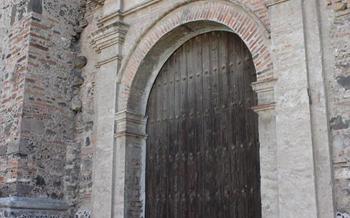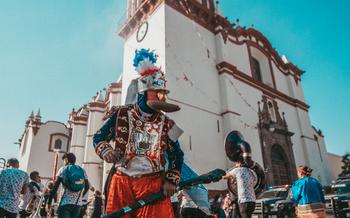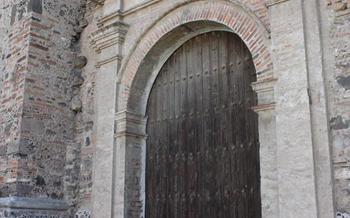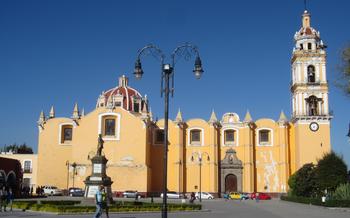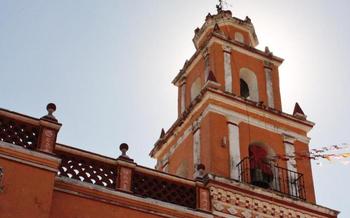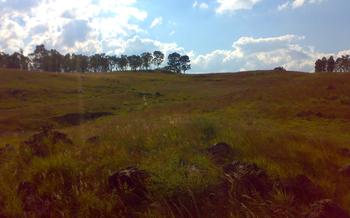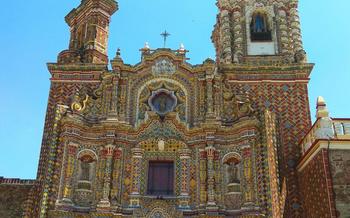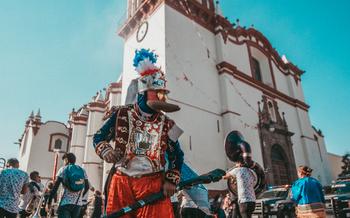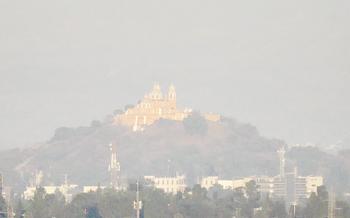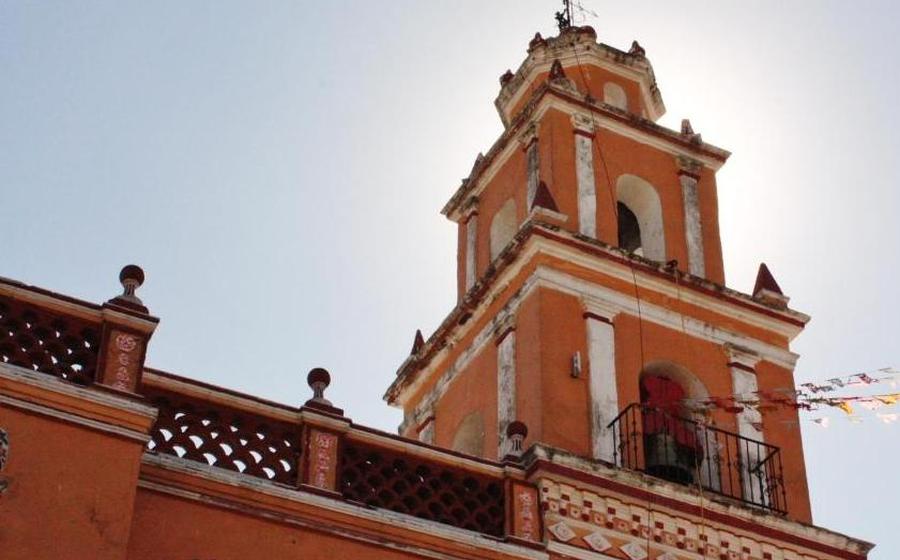
Tonantzintla Observatory
- The Tonantzintla Observatory: A Unique Blend of History and Astronomy
- The Pyramid of Cholula: An Ancient Marvel
- The Church of Santa Maria Tonantzintla: A Baroque Masterpiece
- The Cholula Valley: A Rich Tapestry of Natural Wonders
- The Museo Regional de Cholula: A Window into the Past
- The Zapotec and Olmec Cultures: A Legacy of Ancient Civilizations
- The Feria de Cholula: A Celebration of Culture and Tradition
- The Gastronomy of Cholula: A Culinary Delight
- The Markets of Cholula: A Treasure Trove of Local Goods
- The Nightlife of Cholula: A Vibrant Scene
- The Haciendas of Cholula: A Glimpse into Colonial History
- The Churches of Cholula: A Sacred Journey
- The Festivals of Cholula: A Year-Round Celebration
- Insider Tip: Exploring the Tunnels of Cholula
The Tonantzintla Observatory: A Unique Blend of History and Astronomy
The Tonantzintla Observatory is a captivating blend of rich history and astronomical significance. Its origins date back to the 19th century, when a prominent astronomer, Francisco Javier Chavira, embarked on a mission to establish an observatory that would further the study of celestial phenomena. With meticulous planning and dedication, he selected a strategic location on the slopes of the Cholula Valley, where the clear skies and minimal atmospheric interference provided ideal conditions for astronomical observations.
The architectural design of the observatory reflects a harmonious fusion of neoclassical and Moorish elements. The façade exudes a sense of grandeur, featuring intricate arches and decorative columns that frame the entrance. Upon entering, visitors are greeted by a central courtyard adorned with lush gardens and a striking fountain, creating a tranquil ambiance conducive to scientific pursuits.
The importance of the observatory's location cannot be overstated. Perched atop the Cholula Valley, the observatory commands a clear and unobstructed view of the night sky. This strategic positioning allowed astronomers to conduct observations without the hindrance of urban light pollution, a common challenge in modern-day astronomy.
The Tonantzintla Observatory played a pivotal role in advancing the field of astronomy in Mexico. Through meticulous observations and dedicated research, astronomers at the observatory made significant contributions to our understanding of the cosmos. They discovered new comets, measured the positions of stars, and delved into the mysteries of the solar system, expanding the frontiers of astronomical knowledge.
The Pyramid of Cholula: An Ancient Marvel
Among the many wonders of Cholula, the Great Pyramid stands as a testament to the ingenuity and architectural prowess of ancient civilizations. Known as Tlachihualtepetl, or "made-by-hand mountain," this colossal structure is the largest pyramid in the world by volume, surpassing even the Great Pyramid of Giza in Egypt. Its construction began around the 3rd century BC and continued for several centuries, resulting in a massive pyramid with a base of over 450 meters (1,476 feet) and a height of 66 meters (217 feet).
Unlike the steep-sided pyramids found in Egypt, the Pyramid of Cholula has a stepped or terraced design, resembling a natural hill more than a traditional pyramid. It consists of six superimposed platforms, each with its own staircase leading to the top. The pyramid's exterior was once covered in stucco and painted with colorful murals, but these have faded over time, leaving behind a weathered and timeworn appearance.
The pyramid's unique structure and location have played a significant role in its preservation. Built on top of a natural hill, the pyramid seamlessly blends into the surrounding landscape, making it less susceptible to erosion and natural disasters. This strategic placement has allowed the pyramid to withstand the test of time, remaining largely intact despite centuries of neglect and abandonment.
In modern times, the pyramid has undergone extensive archaeological excavations and restoration efforts, revealing a wealth of artifacts and insights into its ancient builders. Visitors can explore the pyramid's interior through a network of tunnels and chambers, providing a glimpse into the lives and rituals of the ancient inhabitants of Cholula.
The Church of Santa Maria Tonantzintla: A Baroque Masterpiece
The Church of Santa Maria Tonantzintla stands as a testament to the architectural prowess and artistic brilliance of the Baroque period. Its design seamlessly blends indigenous and European elements, creating a unique expression of cultural fusion. The facade boasts an intricate interplay of curves, niches, and pilasters, adorned with an array of sculptures and reliefs that depict biblical scenes and figures.
Stepping inside the church, visitors are met with an explosion of color and ornamentation. Every surface is meticulously decorated with vibrant frescoes, intricate stucco work, and gilded altars. The ceiling is a masterpiece in itself, featuring a stunning depiction of the Assumption of the Virgin Mary, surrounded by a chorus of angels.
The Church of Santa Maria Tonantzintla holds immense historical significance as a site of pilgrimage and devotion. It was constructed in the 16th century to replace an earlier indigenous temple dedicated to the goddess Tonantzin, the mother of the gods. The church's design and iconography reflect this syncretism, incorporating elements of both Christian and pre-Hispanic beliefs.
Today, the Church of Santa Maria Tonantzintla is not only a religious site but also a cultural treasure. Its unique blend of architectural styles and its role in the history of Cholula make it a must-visit destination for anyone seeking to delve into the rich heritage of Mexico.
The Cholula Valley: A Rich Tapestry of Natural Wonders
The Cholula Valley boasts a mesmerizing array of natural wonders that captivate visitors with their beauty and diversity. This fertile valley is surrounded by majestic mountains, creating a picturesque backdrop for its verdant landscapes. Rolling hills adorned with colorful wildflowers and lush vegetation offer a feast for the eyes as you traverse the region. The valley is a haven for nature enthusiasts, providing ample opportunities to immerse themselves in its ecological treasures.
Home to a variety of flora and fauna, the Cholula Valley is a haven for biodiversity. The vibrant ecosystem supports a myriad of plant and animal species, some of which are endemic to the region. Birdwatching enthusiasts can delight in spotting colorful species such as hummingbirds, woodpeckers, and falcons soaring through the skies. The valley is also home to various reptiles, amphibians, and mammals, including lizards, snakes, frogs, and even the occasional coyote.
The Cholula Valley's significance extends beyond its natural beauty; it plays a crucial role in agriculture and conservation. The fertile soil and abundant water resources make it an ideal location for farming. The valley produces a variety of crops, including corn, beans, squash, and chiles, which are essential staples in Mexican cuisine. The region's commitment to sustainable farming practices ensures the preservation of its natural resources while providing sustenance for the local community.
In addition to its agricultural importance, the Cholula Valley is recognized for its conservation efforts. Several protected areas have been established to safeguard the region's unique ecosystems. These reserves provide habitats for endangered species and promote biodiversity conservation. Visitors can explore these protected areas through guided tours, hiking trails, and wildlife viewing platforms, offering an immersive experience in the heart of nature.
The Museo Regional de Cholula: A Window into the Past
Nestled in the heart of Cholula, the Museo Regional de Cholula stands as a testament to the rich cultural and historical heritage of the region. This captivating museum boasts an impressive collection of artifacts and exhibits that offer visitors a glimpse into the past, shedding light on the diverse civilizations that have shaped Cholula's identity.
The museum's collection encompasses a vast array of archaeological treasures, including intricate pottery, finely crafted jewelry, and ceremonial objects that once belonged to the ancient Zapotec and Olmec civilizations. These artifacts provide valuable insights into the daily lives, beliefs, and artistic expressions of these enigmatic cultures.
In addition to its archaeological exhibits, the Museo Regional de Cholula also features displays that delve into the colonial history of the region. Visitors can admire religious artifacts, paintings, and sculptures that showcase the artistic and cultural influences of the Spanish conquistadors.
The museum's interactive displays and educational programs make it an ideal destination for visitors of all ages. Through hands-on activities, multimedia presentations, and guided tours, the museum brings history to life, allowing visitors to gain a deeper understanding of the region's complex past.
Whether you're a history buff, an archaeology enthusiast, or simply someone who wants to learn more about the captivating story of Cholula, the Museo Regional de Cholula is a must-visit destination. This exceptional museum offers a unique opportunity to explore the rich tapestry of cultures that have left an indelible mark on this vibrant city.
The Zapotec and Olmec Cultures: A Legacy of Ancient Civilizations
The Zapotec and Olmec civilizations, with their rich cultural tapestry, played a pivotal role in shaping the cultural identity of Cholula and the surrounding region. The Zapotecs, known for their sophisticated writing system and advanced agricultural techniques, flourished from 500 BCE to 900 CE. They left a lasting legacy in the form of magnificent ruins, including the Pyramid of Cholula, which stands as a testament to their architectural prowess. Their sophisticated urban centers, adorned with intricate carvings and sculptures, showcased their artistic brilliance and cultural achievements.
The Olmecs, who predated the Zapotecs, are renowned as one of the earliest major civilizations in Mesoamerica. They thrived from 1200 BCE to 400 BCE and are credited with creating the colossal stone heads that have become synonymous with their culture. These enigmatic sculptures, often weighing several tons, continue to captivate visitors with their intricate features and enigmatic expressions. The Olmecs also developed a complex system of writing and a sophisticated calendar, demonstrating their intellectual advancements.
Archaeological excavations in the Cholula region have unearthed numerous artifacts, including finely crafted pottery, intricately carved jade ornaments, and elaborate stone sculptures. These discoveries have provided valuable insights into the daily lives, rituals, and beliefs of these ancient civilizations. The Zapotec and Olmec cultures laid the foundation for the cultural heritage of Cholula, leaving an enduring legacy that continues to inspire and fascinate modern-day visitors.
The Feria de Cholula: A Celebration of Culture and Tradition
The all over the country.
The festival has its roots in the early 20th century when it was first organized as a way to promote literacy and education among children and young adults. Over the years, it has evolved into a vibrant celebration that showcases the rich cultural heritage of Cholula and the surrounding region.
The festival typically takes place in September and features a wide range of activities and events, including colorful parades, traditional music and dance performances, craft fairs, food stalls, and book exhibits. Visitors can immerse themselves in the local culture by sampling traditional dishes, admiring the intricate handicrafts, and enjoying the lively performances.
The Feria de Cholula is an important event for the local community, as it provides a platform for local artists, musicians, and artisans to showcase their talents. It is also an opportunity for visitors to learn about the history, traditions, and folklore of Cholula and the surrounding region.
If you happen to be in Cholula during the festival, be sure to join in the festivities and experience the vibrant culture and traditions of this charming city.
The Gastronomy of Cholula: A Culinary Delight
Cholula's gastronomy is a harmonious blend of pre-Hispanic and Spanish influences, resulting in a rich culinary tradition. Must-try dishes include Chiles en Nogada, a dish made with poblano peppers stuffed with picadillo, topped with a walnut-based cream sauce and pomegranate seeds; Pozole, a hearty soup made with hominy, meat, and broth; and Cemitas, a type of sandwich made with a sesame seed bun, filled with various meats, cheeses, and vegetables.
Traditional ingredients and cooking techniques are still widely used, ensuring the authenticity of the local cuisine. Fresh produce, spices, and herbs are sourced from the fertile Cholula Valley, adding vibrant flavors to the dishes.
For a truly immersive experience, visit the local markets to purchase fresh ingredients and interact with the friendly vendors. Don't forget to try the traditional beverages, such as pulque, a fermented drink made from maguey sap, and tequila, a distilled spirit made from blue agave.
The Markets of Cholula: A Treasure Trove of Local Goods
Stroll through the vibrant markets of Cholula and immerse yourself in a world of colors, aromas, and local treasures.
Mercado Municipal de Cholula: This bustling market is a hub of activity, where locals and visitors alike come to buy and sell a wide variety of goods. From fresh produce and spices to traditional handicrafts and souvenirs, you'll find everything you need under one roof.
Mercado de Artesanías: Dedicated to showcasing the artistic talents of the region, this market offers a stunning array of handmade crafts. Browse through intricate pottery, colorful textiles, and unique jewelry, all crafted by skilled artisans using traditional techniques.
Mercado de Comida: Indulge in the culinary delights of Cholula at this market, which specializes in local delicacies. Sample fresh tortillas, savor traditional mole sauces, and satisfy your sweet tooth with homemade candies and pastries.
Mercado de Plantas: For those with a green thumb, the Mercado de Plantas is a must-visit. Here, you'll find a vast selection of plants, flowers, and herbs, as well as gardening supplies and expert advice.
Tips for Shopping in Cholula's Markets: - Be prepared to bargain: Haggling is a common practice in Mexican markets, so don't be afraid to negotiate prices. - Learn a few basic Spanish phrases: Communicating in Spanish will help you connect with vendors and get better deals. - Carry small bills: Many vendors may not have change for large bills, so it's helpful to have smaller denominations on hand. - Respect local customs: Be polite and respectful when interacting with vendors, and observe local customs and traditions.
The Nightlife of Cholula: A Vibrant Scene
Cholula boasts a lively nightlife scene that caters to diverse tastes and preferences. After a day of exploring cultural and historical landmarks, visitors can immerse themselves in the city's vibrant atmosphere. A myriad of bars, clubs, and live music venues offer opportunities to socialize, dance, and enjoy the local music scene. Traditional dance performances and cultural shows showcase the rich heritage of the region, providing a unique and authentic experience. As the night unfolds, unique nightlife experiences await, such as rooftop bars with panoramic views of the city or hidden speakeasies serving handcrafted cocktails. While exploring the city's nightlife, visitors should prioritize safety by staying aware of their surroundings, using reputable transportation services, and avoiding isolated areas. Cholula's vibrant nightlife offers an exciting contrast to its historical charm, making it a well-rounded destination for travelers seeking a blend of culture and entertainment.
The Haciendas of Cholula: A Glimpse into Colonial History
The haciendas of Cholula stand as proud testaments to the region's rich colonial past and agricultural heritage. These sprawling estates, with their grand architecture and lush landscapes, once served as the centers of vast agricultural enterprises, playing a pivotal role in the region's economic development.
Their history dates back to the 16th century when Spanish conquistadors established large estates known as haciendas to exploit the land's agricultural potential. These haciendas, often encompassing thousands of acres, became self-sufficient units, producing a variety of crops, including corn, wheat, beans, and sugar cane.
The haciendas' architectural grandeur reflects the wealth and power of their owners. Many feature elegant mansions with intricate facades, expansive courtyards, and graceful arcades. The haciendas also boast elaborate gardens, orchards, and fountains, showcasing the owners' taste for luxury and comfort.
Beyond their economic significance, the haciendas played a crucial social and cultural role in colonial society. They served as hubs of activity, where workers, artisans, and merchants gathered to conduct business, exchange ideas, and celebrate religious festivals.
Today, many of the haciendas have been transformed into museums, cultural centers, and hotels, offering visitors a unique glimpse into the region's colonial heritage. These haciendas provide a fascinating journey into the past, showcasing the architectural wonders, agricultural traditions, and social dynamics that shaped Cholula's colonial identity.
The Churches of Cholula: A Sacred Journey
Cholula is home to a remarkable collection of churches, each with its unique architectural style and historical significance. These sacred spaces played a pivotal role in the spread of Christianity during the colonial era and continue to hold a special place in the hearts of the local community.
One of the most notable churches is the Templo de San Francisco Acatepec, renowned for its exquisite Baroque facade and intricate interior decorations. The church was built in the 16th century and features a stunning altarpiece adorned with gold leaf and vibrant colors.
Another must-visit church is the Templo de Santa Maria Tonantzintla, a UNESCO World Heritage Site. This architectural masterpiece is known for its elaborate Churrigueresque style and features an ornate facade covered in intricate carvings and sculptures. The interior of the church is equally impressive, with its colorful murals and gilded altars.
The Templo de San Pedro Cholula is another notable church, with its distinctive Renaissance-style architecture. The church was built in the 16th century and features a beautiful interior with a vaulted ceiling and a series of impressive murals depicting scenes from the Bible.
These churches are not merely architectural wonders but also hold deep spiritual significance for the local community. They serve as venues for religious ceremonies, festivals, and processions, fostering a sense of unity and devotion among the faithful.
Whether you are a history buff, an architecture enthusiast, or simply seeking spiritual enlightenment, the churches of Cholula offer a sacred journey that will leave an indelible mark on your soul.
The Festivals of Cholula: A Year-Round Celebration
Cholula is a city that pulsates with life, and nowhere is this more evident than in its vibrant festivals. Throughout the year, the streets come alive with music, dance, and colorful processions as the city celebrates its diverse cultural and religious heritage.
One of the most famous festivals is the Feria de Cholula, held in late September to commemorate the city's patron saint, the Virgin of the Remedies. This week-long extravaganza features lively parades, traditional dances, bullfights, and a bustling fairground with food, music, and games.
If you're interested in religious festivals, don't miss the Feria de San Pedro Cholula, held in late June, which celebrates the city's patron saint, Saint Peter. This festival features colorful processions, solemn masses, and traditional music performances.
For a taste of Cholula's agricultural roots, attend the Feria del Elote, held in August, which celebrates the city's famous corn crop. This festival showcases a variety of corn-based dishes, as well as traditional dances and music.
No matter what time of year you visit Cholula, you're sure to find a festival that will immerse you in the city's rich culture and traditions. Embrace the festive spirit, join in the celebrations, and create memories that will last a lifetime.
Insider Tip: Exploring the Tunnels of Cholula
Beneath the bustling streets of Cholula lies a hidden world of tunnels, a testament to the city's rich and layered history. These subterranean passageways were once used by the ancient inhabitants for various purposes, including water management, religious ceremonies, and defense. Today, they offer a unique opportunity for visitors to delve into the city's past and discover its hidden secrets.
The tunnels are located beneath the city center and can be accessed through guided tours offered by local providers. Visitors are equipped with helmets and flashlights as they embark on an adventure through the labyrinthine tunnels, which stretch for several kilometers. The tours provide insights into the history and significance of the tunnels, as well as the challenges faced by the ancient builders.
Exploring the tunnels of Cholula is a truly unique experience that allows visitors to step back in time and gain a deeper understanding of the city's cultural heritage. It is an adventure not to be missed for those seeking to discover the hidden gems of Cholula.
